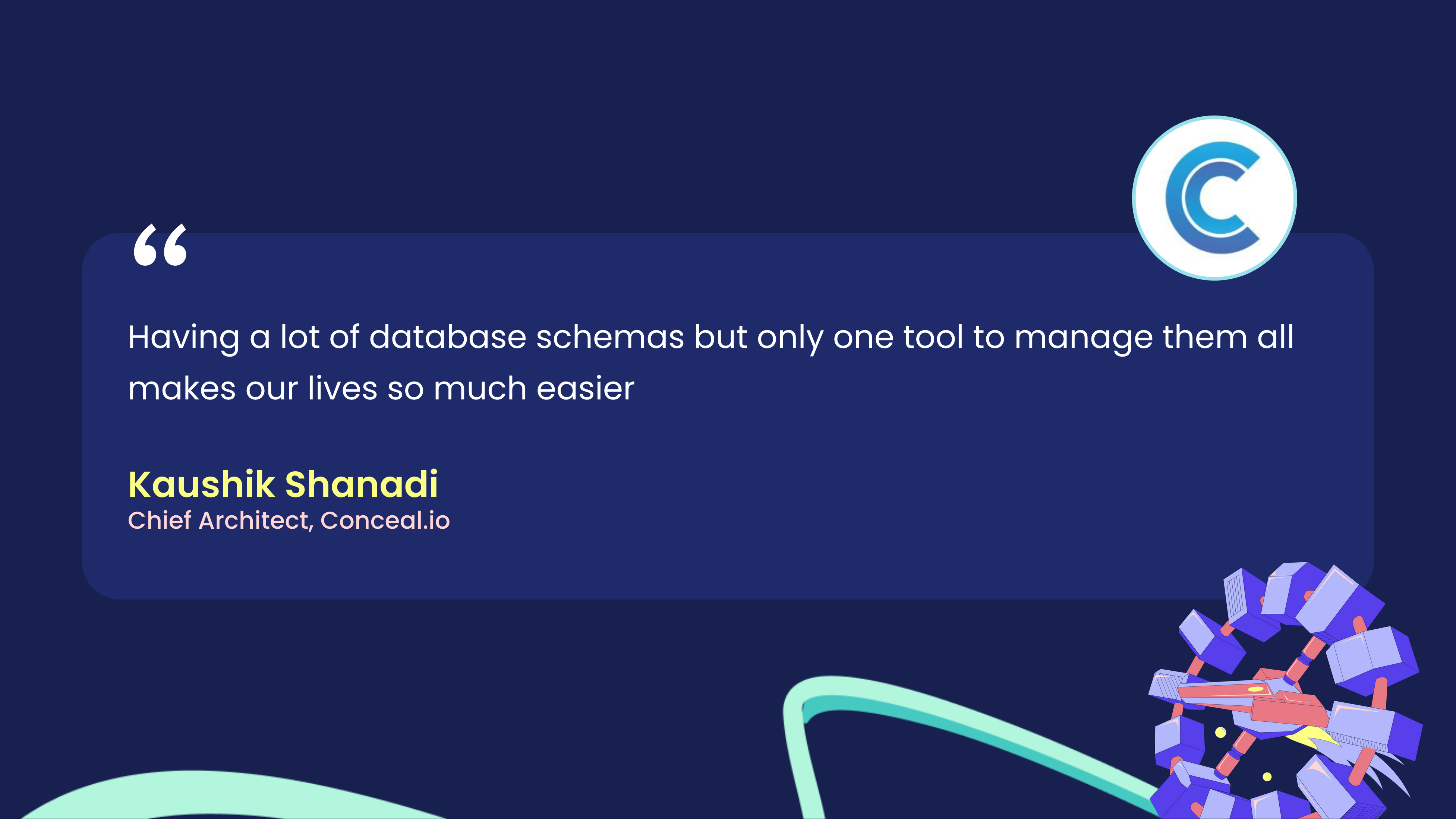How Conceal.IO Manages 1,500+ Redshift Schemas Using Atlas
"Everything on Atlas is just making too much sense for us."
— Kaushik Shanadi, Chief Architect
Conceal, a cybersecurity company, creates a secure browsing experience using a browser extension. With a lean engineering team, When Conceal shifted from serving individual consumers to working with managed service providers (MSPs), their clients' security requirements drove the need for a robust, multi-tenant architecture to ensure data isolation and scalability.
Kaushik Shanadi, VP and Chief Architect, led the charge in finding that solution.

Evaluating Alternative Solutions
To meet the growing business demands and provide sufficient isolation for each customer’s data in a scalable and secure manner, the team considered three alternatives:
-
Keep a Single Database, Isolating on the Application Layer: This option was quickly dismissed because of the team's negative experience with this solution.
Like many others, they found that adding a
tenant_idcolumn to every table and hoping that developers remember to filter by it on every query was a burden and risk they were not willing to take. Additionally, this was not acceptable to some of their customers, who required strict data isolation. -
Database-per-Tenant Approach: While this approach ensured both data isolation and scalability, the cost of maintaining a Redshift cluster for each customer made this alternative prohibitive.
-
Hybrid Solution (Schema-per-Tenant): Ultimately, they chose a schema-per-tenant model, which kept the data isolated and secure without the high cloud costs. This approach also offered the flexibility to switch specific customers to their own isolated database if needed.
"It was way too easy to do that with Atlas compared to any other method," Kaushik remarked.
The Challenge of Schema-per-Tenant Architecture
Schema-per-tenant architectures present unique challenges, primarily around managing database schema migrations:
- Migration duration scales linearly with tenant count.
- Detecting inconsistencies becomes a needle in a haystack problem.
- Rollbacks are difficult to orchestrate.
Atlas overcomes these challenges with its declarative schema-as-code approach. By automating migration planning, Atlas ensures that every schema remains consistent, aligned, and easy to manage.
Read more about the challenges and how Atlas solves them here
Safety First: Managing 1,500+ Schemas with 7 Engineers Using One Tool
Implementation
According to Kaushik, the implementation process was easy and smooth. Amazon Redshift was a requirement for both long-term storage and machine learning (ML) training data. "Migrating with old migration tools is a nightmare," said Kaushik. After discovering that Atlas supports Redshift, he ran a few POCs locally to test Atlas.
"I was able to get everything working and saw how fast the migration process was, so we pushed it to development," he explained.
Outcome
By leveraging Atlas' declarative Schema-as-Code capabilities and its ability to manage schema per tenant architectures, Conceal.IO successfully manages a fleet of over 1,500 identical Redshift schemas, isolating customers' data from one another as required. This unified approach ensures that all schemas are designed consistently, aligned, and kept in the same state. This alignment has resulted in:
- Faster feature deployment across all customers
- Improved analytics and ML preparation
- Faster onboarding for new engineers
- The ability to add more customers as needed without worrying about deployments becoming slower as they grow
- Fixed operational costs, ensuring scalability without an exponential rise in expenses
All of this was achieved in a safe and secure environment.
"Having a lot of database schemas but only one tool to manage them all makes our lives so much easier", Kaushik added.
Next Steps
The Conceal.IO team plans to use the upcoming holiday season to migrate their production workloads running on PostgreSQL into Atlas as well. Tired of dealing with constant migration issues, Kaushik is confident that “using Atlas will make it so much easier.”
"Support has been awesome, and the speed has been incredible too," summarized Kaushik. "Everything I need from an enterprise solution is available out of the box. It was almost too easy to say — let’s just use Atlas."
Getting Started
Atlas applies the declarative mindset to database schema management, like Terraform, but for databases. Using its unique, schema-as-code approach, teams can automatically inspect existing databases and get started in no time.
Like Conceal.IO, we recommend anyone looking for a schema migration solution to get started with Atlas by trying it out on one or two small projects. Read the documentation, join our Discord community for support, and start managing your schemas as code.